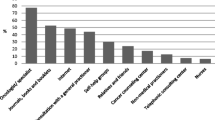Abstract
Cancer patients are increasingly using the Internet to learn about their disease, connect with others undergoing similar treatments and obtain support outside of the clinical encounter. The goal of this project was to explore how patients with gynecological cancers (ovarian, cervical, and endometrial) used the Internet as an information resource and how this influenced their treatment decisions and interactions with their health care specialists. From 2013 to 2014, ovarian, endometrial, and cervical cancer patients attending a comprehensive cancer centre were invited to complete a 24-item paper questionnaire detailing their experiences in searching the Internet. Twenty-eight patients completed survey. The largest portion of participants had an ovarian cancer diagnosis (61 %), followed by endometrial (29 %) and cervical cancer (11 %). Results indicate that the majority (85 %) of patients used the Internet as a resource to learn about their gynecological cancers. Most respondents (89 %) used Google as their search engine, and some used multiple search engines. The most frequently searched topics included treatment information (85 %), management of symptoms/treatment toxicity (59 %), and alternative treatments (37 %). Many patients (74 %) felt that the Internet was a useful tool for understanding their diagnosis; however, 33 % reported that the Internet was somewhat hard to understand. Most (78 %) patients reported that Internet information increased their understanding of their diagnosis, and 56 % felt it did not affect their decision-making. This study highlights how gynecological patients are accessing cancer information online and how physicians may support this within the clinical setting.
Similar content being viewed by others
References
Shea-Budgell M, Kostaras X, Myhill K, Hagen N (2014) Information needs and sources of information for patients during cancer follow-up. Curr Oncol 21:165–173
Lee K, Kreshnik H, Jeffery H, Lynne E (2014) Dr. Google and the consumer: a qualitative study exploring the navigational needs and online health information-seeking behaviors of consumers with chronic health conditions. J Med Internet Res 16:e262
Sawka A, Straus S, Gafnis A, Brierley J, Tsang R et al (2011) How can we meet the information needs of patients with early stage papillary thyroid cancer considering radioactive iodine remnant ablation? Clin Endocrinol 74:419–423
Goto Y, Nagase T (2012) Oncology information on the Internet. Jpn J Clin Oncol 42:368–374
Hesse B, Nelson D, Kreps G, Croyle R, Arora N et al (2005) Trust and sources of health information: the impact of the Internet and its implications for health care providers: findings from the first Health Information National Trends Survey. Arch Int Med 165:2618–2624
Ziebland S, Chapple A, Dumelow C, Evans J, Prinnjha S et al (2004) How the Internet affects patients’ experience of cancer: a qualitative study. Br Med J 328:564
Selman T, Prakash T, Khan K (2006) Quality of health information for cervical cancer treatment on the internet. BMC Womens Health 6:9
Canadian Cancer Society. 2015. Canadian Cancer Statistics. http://www.cancer.ca/en/cancer-information/cancer-101/canadian-cancer-statistics-publication/?region=on. Accessed 15 June 2015.
American Cancer Society. 2015. Cancer facts and figures. http://www.cancer.org/research/cancerfactsstatistics/. Accessed 16 June 2015.
Ngyuen S, Ingledew P-A (2013) Tangled in the breast cancer web: an evaluation of the usage of web-based information resources by breast cancer patients. J Cancer Educ 28:662–668
McHugh S, Corrigan M, Morney N, Sheikh A, Lehane E et al (2011) A quantitative assessment of changing trends in Internet usage for cancer information. World J Surg 35:253–257
Hamilton, Sarah, Scali, Elena, Yu, Irene, Gusnowski, Eva, Ingledew, Paris-Ann. 2014. Sifting through it all: characterizing melanoma patients’ utilization of the Internet as an information source. Journal of Cancer Education epublication
Statistics Canada. 2014. Canadian Internet Use and e-Commerce in Canada Survey. http://www.statcan.gc.ca/eng/survey/household/4432b. Accessed 12 June 2015
Pew Research Center. 2014. Internet use over time. http://www.pewinternet.org/data-trend/internet-use/internet-use-over-time/. Accessed 16 June 2015.
Ingledew P-A, El-Zammar D, Scali E, Brar B, Lin J et al (2014) Caught in the web: the quality of online resources for cancer patients. Int J Radiat Oncol 90:S604
Harris I (2003) What does “The discovery of grounded theory” have to say to medical education? Adv Health Sci Educ 8:49–61
Castleton K, Fong T, Wang-Gillam A, Waqar M, Jeffe D et al (2011) A survey of Internet utilization among patients with cancer. Support Care Cancer 19:1183–1190
Solomonides A, Mackey T (2015) Emerging ethical issues in digital health information. Camb Q Healthc Ethics 24:311–322
Diviani N, van den Putte B, Stephano G, van Weert J (2015) Low health literacy and evaluation of online health information: a systematic review of the literature. J Med Inf Res 17:e112
Zschorlich B, Gechter D, Janben I, Swinehart T, Wiegard B et al (2015) Health information on the Internet: who is searching for what, when and how? J Evid Qual Health Care 109:144–152
Ann IP, Irene Y (2014) Sifting through it all: the quality of online resources for ovarian cancer patients. Radiother Oncol 1162(s1):66
Ofran Y, Paltiel O, Pellag D, Rowe J, Yom-Tov E (2012) Patterns of information-seeking for cancer on the internet: an analysis of real world data. PLoS One 7:e45921
Metz J, Devine P, DeNittis A, Jones H, Hampshire M et al (2003) A multi-institutional study of Internet ultilization by radiation oncology patients. Int J Radiat Oncol Biol Phys 56:1201–1205
Laugesen J, Hassanein K, Yuan Y (2015) The impact of Internet health information on patient compliance: a research model and an empirical study. J Med Inf Res 17:e143
Chen X, Siu L (2001) Impact of the media and the internet on oncology: survey of cancer patients and oncologists in Canada. J Clin Oncol 19:4291–4297
Author information
Authors and Affiliations
Corresponding author
Rights and permissions
About this article
Cite this article
McLeod, J., Yu, I. & Ingledew, PA. Peering into the Deep: Characterizing the Internet Search Patterns of Patients with Gynecologic Cancers. J Canc Educ 32, 85–90 (2017). https://doi.org/10.1007/s13187-016-1002-9
Published:
Issue Date:
DOI: https://doi.org/10.1007/s13187-016-1002-9




